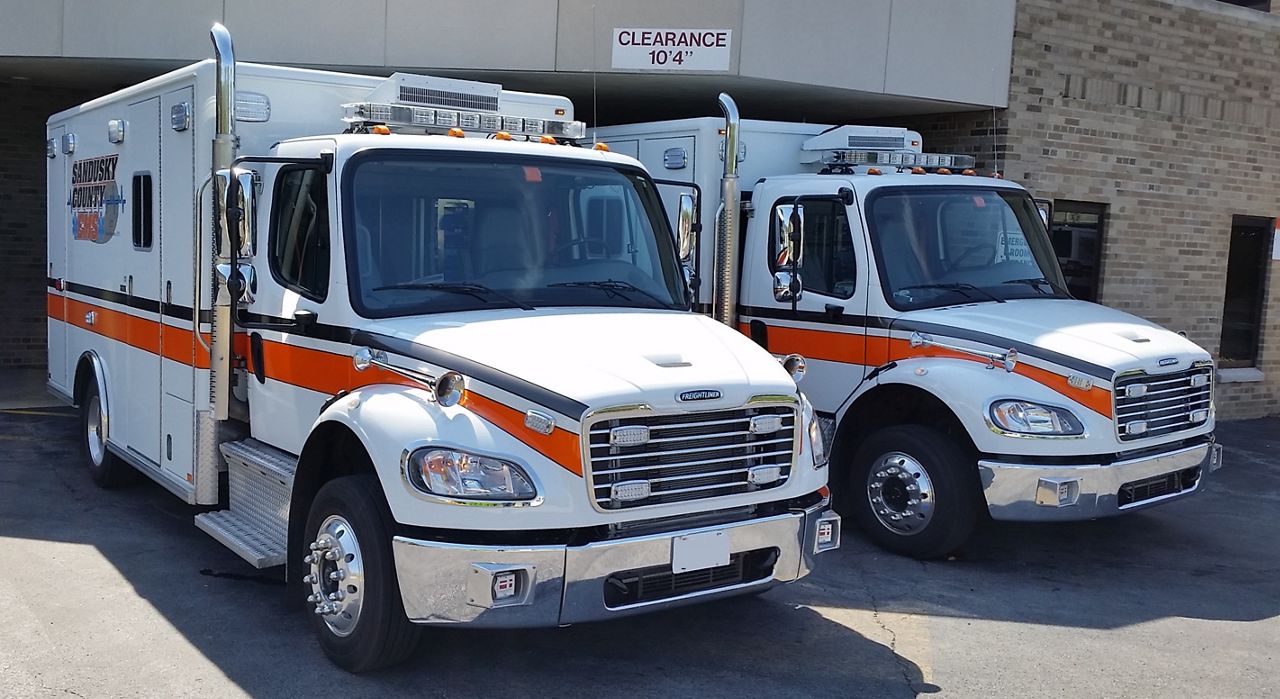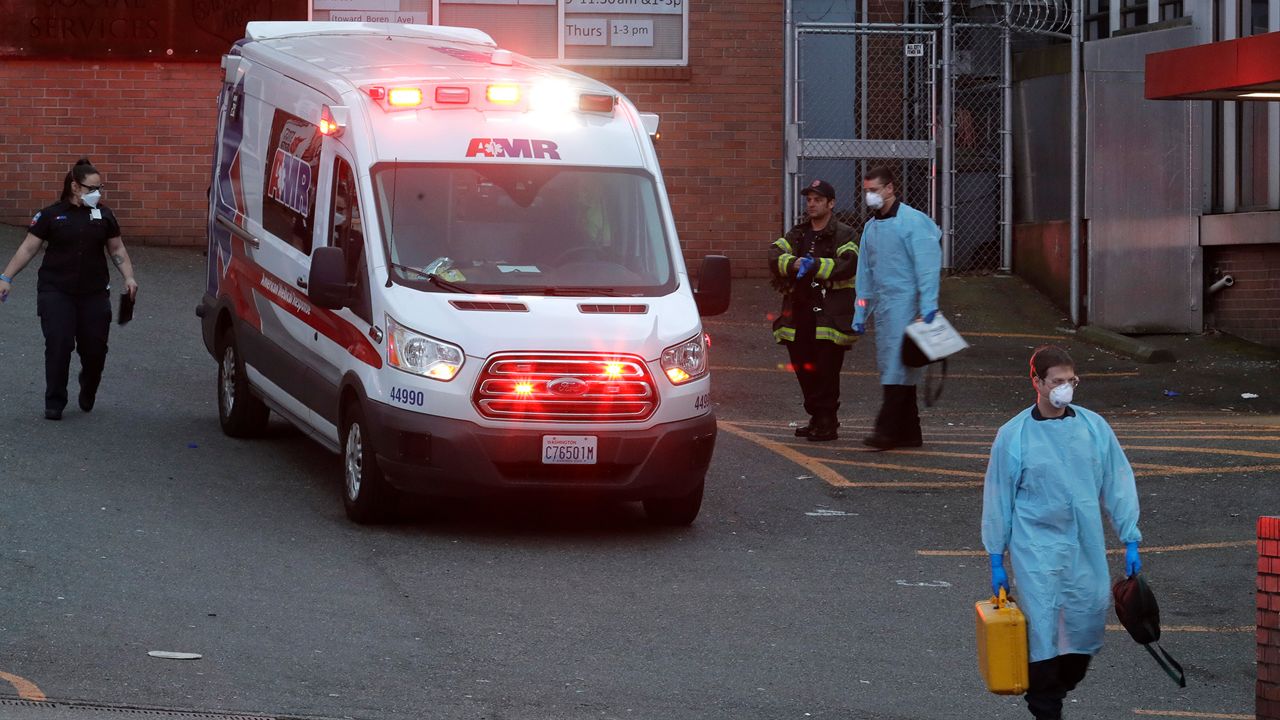FINDLAY, Ohio — Hanco EMS, an ambulance service in Findlay, said it just recorded its busiest week in the company’s history. The dispatch phones are ringing with COVID-19 calls.
What You Need To Know
- When hospitals fill, long ambulance trips become a challenge for EMS providers
- On Monday, 4,795 COVID-19 patients were hospitalized in Ohio
- Patients are also experiencing delays for transport between hospitals
Many northern Ohio hospitals have been on EMS “bypass” or “diversion” status on a regular basis in recent weeks, which means patients who need a transport may not be taken to the nearest hospital.
They’re transported to whichever hospital is assigned to take them, with some exceptions for the most critical patients, said Kent Appelhans, director of Hanco EMS, which is under the umbrella of Blanchard Valley Health System.
“Blanchard Valley has not gone on EMS bypass, however, we are the only ones in the region, or one of the only ones in the region I'm familiar with, that hasn't had to do that,” he said. “We've been extremely busy, but our ER has not had to go on bypass.”
Appelhans, who is also chairman of the State Board of EMS and Fire, said Ohio EMS agencies have been stretched thin by the current surge. In some areas, the situation is dire.
Ambulances are dealing with a high volume of calls, longer transport times to more distant hospitals and longer drop-off times when they arrive at busy emergency departments.
“EMS services throughout the state are seeing significantly higher return times, back-in-service times,” Appelhans said.
Dr. Jennifer Hanrahan, an infectious disease doctor at the University of Toledo Medical Center, said that they’ve been on bypass status frequently in recent weeks due to high numbers of COVID-19 patients, an overwhelming majority of whom are unvaccinated.
Inside the hospital, patients are experiencing unprecedented wait times to be moved from the emergency department to an actual hospital bed.
“When people come in who do require admission to the hospital, sometimes they're having to wait in the emergency department for a day or two,” she said. “There's just a limited number of beds available in the hospital."
After Thanksgiving, she said the hospital had patients coming in who’d been exposed at family gatherings, and she fears that the upcoming holidays will continue to exacerbate the state’s problems in the weeks to come. After someone contracts the virus, it can be 10 days, or even up to three weeks until they need to be taken to the hospital.
In some instances, EMS crews in Ohio have spent an hour or more trying to offload a patient once they get to an emergency room, Appelhans said. Services, like Hanco EMS, that also transport patients between hospitals said they are dealing with a large volume of those types of transports. The most critical patients, for example, will often need to be moved to a larger hospital that provides ECMOs, which is an advanced type of life support.
“Elsewhere in the state, there are patients that wait for 12, 24 or more hours to get transported out from a hospital because of the staffing issues that are being seen,” Appelhans said.
On Monday, members of the Ohio National Guard began a mission to support strained hospitals in the state. The state announced Friday it is activating 150 National Guard members who are medical personnel — nurses and EMTs — and an additional 900 nonmedical personnel to help with transportation and other matters.
The state has reported more than 7,100 COVID-19 deaths since September. On Monday, 4,795 COVID-19 patients were hospitalized and seven-day average cases were at 8,290, according to state data.

Sandusky County EMS Chief Jeff Jackson said that last month was just as busy as November was last year. December transport numbers appear to be on track to surpass last year’s numbers, he said.
The two area hospitals, ProMedica Memorial Hospital and the Bellevue Hospital, have both gone on bypass status for periods of time during the last few weeks, which is a significant challenge for EMS crews, he said.
“With the bypass, it just takes longer for the patients to get a turnaround time at the ER,” he said. “The local hospitals have been really, really good about keeping their doors open, but when they go on bypass that’s a big statement because they're that full. When that happens, it'll add probably at least 10 more minutes to a transport.”
When ambulances arrive at the home of a COVID-19 patient, one crew member approaches the home and knocks, while the other prepares to bring in the equipment that may be needed, Jackson said. Oftentimes, EMS responders are entering small homes where multiple members of the household are sick, so they are wearing full PPE — masks, goggles, gloves and gowns.
Capt. Amanda McGinnis, who leads 24-hour shifts and responds to critical calls from Sandusky residents, said she and her colleagues were uneasy about the COVID-19 runs earlier in the pandemic when vaccines weren’t available and less was known about the protection of masks.
Now, the COVID-19 calls have become routine, but it’s the sheer volume that makes the work daunting.
“We are very busy, especially with transports and needing more ambulances sometimes than we have because they're getting prolonged at the hospital, and trying to flip around,” she said. “We just rapidly move as quickly as possible and get them to the closest most appropriate facility that we can.”
COVID-19 calls come in at all hours, from all areas of the county. When there’s an influx and the ambulances are busy, Jackson said they’ll move the available ambulances to the center of the county. That avoids scenarios where an ambulance would have to drive from one end of the county to the other, and the central area has the most population.
“We'll start anticipating where the next call is going to be at,” Jackson said. “We’ll move the far-west squad central, or we’ll move the far-east squad central for coverage. We’ve also had our far-west squad be the far-east squad this year — that's pretty crazy.”
Even with ambulances busy, residents should not hesitate to call 911 if a patient’s condition is deteriorating at home, said Roxanne Williams, director of corporate quality and patient safety for Blanchard Valley Health System.
“What I would say is early intervention, contacting your primary care provider at the time of diagnosis, seeing if there's any early treatment that's available that they qualify for is going to be much better than waiting until they're so short of breath that they have to call EMS,” she said.



